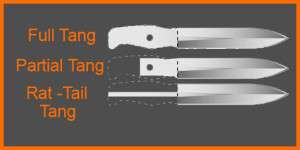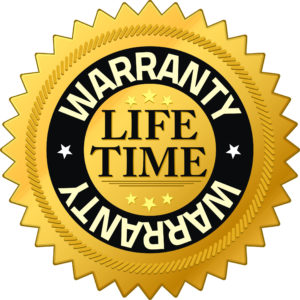With sunnier weather on the way, many people are going to spend more time outdoors. This makes it a perfect time to invest in a new survival knife.
You have lots of options out there when choosing a knife, and some people would have you think the flashiest, most expensive knife is the way to go.
Not necessarily true!
If you know what to look for in a survival knife, you can find one that’ll serve you for years in survival scenarios. Plus, you won’t have to pay an arm and a leg for it, either.
Here’s what to look for in your survival knife.
1. Tang
No, we're not talking about the astronaut drink mix. When it comes to survival knives, tang refers to how long the knife’s core is. Here's a handy graphic from www.cloakanddagger.ca that shows what we mean:

Another benefit of a full tang knife? You'll be able to make a new handle out of cord if your handle ever breaks. Simply wrap paracord tightly around the handle, and you’re good to go.
2. Should it Fold?
Some folding knives are labelled as “survival knives.” Even if their packaging promises that these knives are the “ultimate” in survival, should you choose these over a non-folding knife?
No! Your survival knife should ideally be a solid piece of metal with a handle. You should NOT get a folding knife for several reasons:
Folding knives get dirty
They’re more likely to wear out or break over time
You can’t put as much pressure on the blade
Replacing the handle is very difficult
This isn’t to say a folding knife doesn’t make a great second survival knife or an everyday carry knife (in fact, they’re perfect for everyday carrying). But if you need a primary survival knife, get one that doesn’t fold.
3. Blade Length
The length of your blade depends on your personal preference, so here are a few things you should consider:
Will you carry your knife with you on a daily basis?
Will you carry it on your belt, in a bag, or in a deep pocket?
How comfortable are you using a larger knife for delicate work (such as screw driving with a large tip)?
Is the edge serrated?
In general, a large survival knife like Rambo has is a little much. A knife you can manage is a smarter choice. Try to find one between 6 to 9 inches.
4. What Kind of Tip Should You Choose?
Some people think it would be cool to have some sort of fancy tip on their survival knife, like a hook or curve. DONT do this! Remember, your survival knife is used for a lot more than cutting. Getting a weird tip may sound useful in the store, but you'll regret the decision in a survival scenario.
Instead, choose a normal pointed tip. This allows you to use your knife as a screwdriver, can opener, and all-around tool. It’s simply more versatile and useful.
5. Serrated blades
The choice of getting a serrated blade or not is up to you, but never get a knife that's entirely serrated. Here's a quick pros and cons of a partially serrated blade
Non serrated (straight) blade: Great for chopping, making clean cuts, and general use. Can be sharpened easily.
Serrated: Better for sawing and cutting through fibrous materials, but require a special sharpener.
6. Single or Dual Edge Blade?
You have the choice between a blade with one edge (where one edge is sharp and one is blunt) and a dual-edge blade (where both edges are sharp).
For your survival knife, you’ll want to choose a knife where only one edge is sharp and the spine is flat.
Some people may think twice the blade edges means you’ll have twice the knife. Not quite. In a survival situation, a flat spine can be used as a strike for a fire-starting ferro-rod. It’s also great for a thumb rest son you can apply more pressure to your blade (or for more control during carving, such as making triggers and traps). Overall, there are simply more advantages to a flat-ground edge than a dual-edge.
7. Sheath It
Finally, this is completely up to you, but many people prefer to have survival knives they can easily sheath. Sometimes this means a belt sheath for easy access. You can also get a sheath you can use in a backpack. With the guidelines above, you should be able to find a great survival knife. By shopping around, you’ll be able to find one at a price that’s great, too.
Do you have any specific survival knives you like? Mention them on our Facebook page or in the comments below!
Thanks,
Jeff “The Berkeyguy”







I like the Cold Steel SRK. Manageable size, nice grip, quality blade, reasonable price.
Nice call Bobby, wouldn’t mind having one of those myself.
I have numerous Knives but my favorite survival bushcraft type Knives are either my top’s b.o.b field craft knife or my battle horse knives one is the plsk1 or pathfinder scout I also carry a frontier 1st neck knife from battle horse knives also a great secondary knife I like is my Mora bushcraft black great little knife
Sean, the Mora Bushcraft looks like a great knife for the money.
Been carrying the same knife for 37 years. Randall No.1 (fighter)
One thing that you don’t mention is the plethora of hollow handle ” survival” knives out there. Unless it’s a Phrobis M9 bayonet, the handle weakens the knife. For a pure tough knife, the Cold Steel Bushman one piece knife is excellent. The tubular handle allows for easily conversion to a spear, and is incredibly tough.
ColdSteel Bowie Bushman Hollow-Handle knife is hands down the best bush knife you can find for less than $25
Thanks for the feedback, Ryker.